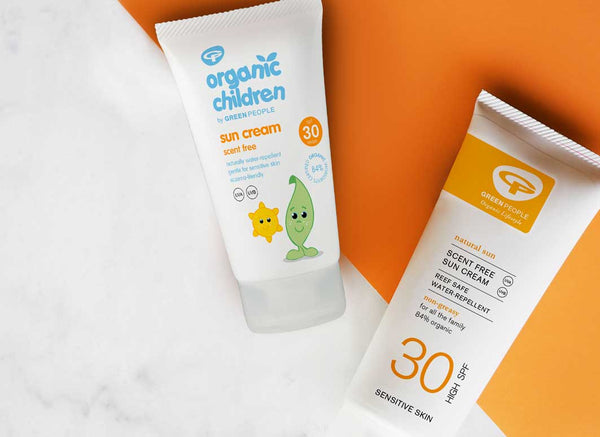This guide from Green People UK provides information on SPFs and UV protection.
We dispel the most commonly held misconceptions regarding the differences and effectiveness of Sun Protection Factors (SPF) and explain why organic sunscreens are so much gentler on your skin than many traditional high street sun lotions.
Organic vs high street sun creams
The main difference between organic and high street sun creams is that organic sun care is usually much gentler on your skin, as it does not contain some of the harsh ingredients used in traditional formulations.
Non-toxic UV filters
Green People’s organic sun creams provide natural protection through safe, non-toxic filters. Unlike some chemical UV filters, our UV filters do not cause skin reactions or harm the environment.
How is the SPF calculated?
SPF stands for Sun Protection Factor and measures the protection against the UV rays which cause sunburn. These rays are known as UVB rays.
SPF ratings are a measure of the length of time that a person can stay in sunlight without their skin visible burning when using a sun lotion compared to the time they would start to burn without protection.
As an example, if a person with a particular skin type were to start to get skin redness after say 8 minutes of unprotected sun exposure, using an SPF15 sun lotion they would be able to spend 120 minutes or 2 hours in the same strength sunlight before starting to get skin redness.
Applying an SPF30 product would enable them to spend 240 minutes or up to 4 hours in the same strength of sunlight before starting to get skin redness.
The actual times will vary depending on the skin type and tanning ability of the individual, and on the strength of the sunlight, but the multiplication factor remains the same.
Do I get twice the protection by using SPF30 vs SPF15?
NO - An SPF15 sun lotion, when applied properly, protects you against 93% of UVB. An SPF30 protects you against 97% of UVB.
Sun filters: physical and chemical
It is important to be aware that the SPF of a sun lotion only indicates the level of protection against UVB radiation. It does not tell you anything about the protection it offers against dangerous UVA light.
This means that whilst the skin will not show visible signs of UV damage and will not go red and burn, without regular reapplication the UVA radiation could still be getting through and causing long-term damage to the living skin cells in the deeper underlying layers of the skin.
It is very important to apply your sun cream regularly and liberally, no matter what SPF you choose. Read about how to apply sun cream.
Charlotte Vøhtz says:
“Too many people are suffering needlessly from skin cancer. We know that applying SPF daily is key to preventing this but the truth is, many are underapplying their sunscreen and relying on a false sense of protection from insufficient SPF.
It's a misconception that if you haven’t burned, no damage has been done. The reality is that it is essential to shield your skin from both UVA and UVB rays. This can only be achieved by applying broad-spectrum SPF regularly and liberally throughout the day. Remember, if you don't apply enough, you won't even come close to the advertised level of protection.”
Discover our beautiful natural sun creams
What makes them different?
- Natural & organic
- Gentle on sensitive skin & prickly heat
- Reef-safe
- Non-greasy
- Water-repellent
Our friendly UK customer care team is happy to help you with any questions you may have about UV protection and our organic sun creams. Please call us on 01403 740350 or leave your comment or question below.















